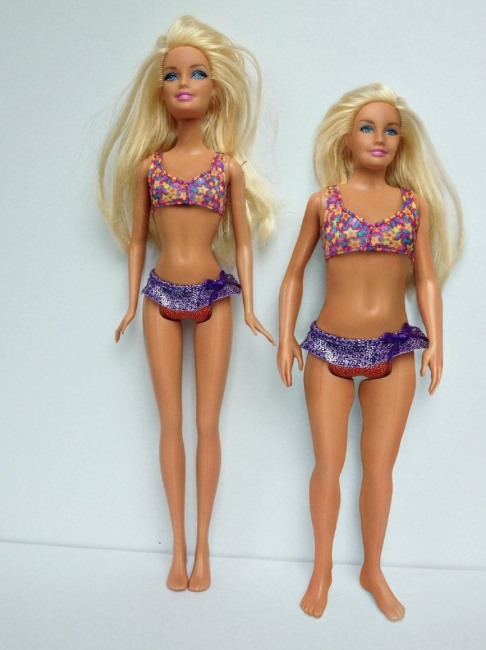The battle over whether Barbie is bad for girls self-image got heated on Monday, Fast Company published an interview with a lead Mattel designer who led a vigorous defense of Barbie’s impossible and much-maligned proportions.
Kim Culmone, VP of Design at Mattel explained why the company still produces a doll with measurements that if real, would result in a woman with half a liver who could only walking on all fours. “Barbie’s body was never designed to be realistic. She was designed for girls to easily dress and undress.”
That justification for Barbie’s outrageous silhouette falls flat with experts in child psychology and female body image. Those pointy feet might be easier to slip into those tight pants, “But those boobs…” said Dr. Sharon Lamb, chair of University of Massachusetts Boston’s School of Psychology. “I don’t think Barbie’s breasts were designed to help Barbie’s clothes go easily on.”
And what about the accusations that Barbie’s unrealistic cinches and curves contribute to young girls’ unhealthy body image?
According to Mattel’s Culmone, Barbie is not the problem: “Girls view the world completely differently than grown-ups do. They don’t come at it with the same angles and baggage and all that stuff that we do. Clearly, the influences for girls on those types of issues, whether it’s body image or anything else, it’s proven, it’s peers, moms, parents, it’s their social circles.”
Mattel has some scientific support for that view. In a USA Today article, Dr. Leslie Sim, clinical director of Mayo Clinic’s eating disorders program and a child psychologist, also pointed the finger not at Barbie’s or the media, but moms:
“Moms are probably the most important influence on a daughter’s body image. Even if a mom says to the daughter, ‘You look so beautiful, but I’m so fat,’ it can be detrimental,” she said.
But other experts disagree.
Dr. Deborah Tolman, professor of psychology and social welfare at City University of New York says that there is a large and growing body of literature that shows the negative impact these toys have on developing children. A 2006 University of Sussex study said that Barbies and similar toys “may damage girls’ body image, which would contribute to an increased risk of disordered eating and weight cycle.”
Tolman wasn’t surprised that Mattel blamed home influences, “It’s such an old story, let’s just blame moms for everything.”
Meanwhile, Lamb, who specializes in the sexualization of children, says that Mattel’s defense “is just a marketing strategy… I think that just because parents influence children too doesn’t mean that Barbie doesn’t. It’s not an either or.”
Both Tolman and Lamb say that understanding the interplay between the mother-daughter and their environment is key. “Moms and girls don’t have a relationship in a vacuum,” Tolman says. “We are having those relationships and bringing those girls up in a cultural stew that is filled with these images that are literally, and Barbie is just the pinnacle of this, physically impossible.” This then stirs the urge to keep trying (and spending) to look like that ideal. But mothers can mediate that urge and put Barbie and her equally un-realistic sisters (like the Monster High and Bratz dolls), into context.
Barbie’s sales, however, were down 13% over the holiday season while other toys were up. Brands like Monster High have taken the center stage. And they might be even worse than Barbie with their prepubescent bodies and uber-sexualized clothes.
Lamb noted that Barbie was designed with their shoulders back and chest proudly out so that “girls should be proud of their bodies and not hunched over and ashamed when they started developing… when they make these dolls look like [they are] 11 or 12, they are introducing a teenage life much earlier.”
But Tolman doesn’t think we should split hairs: “Let’s just put them all in the pot together as all being problematic.”
Mattel’s Culmone, however, doesn’t see a strong impetus to change Barbie’s measurements. “To me, there isn’t an objective to change to proportion of Barbie currently,” she said.
But this might not be true. Not only are sales of American Girl dolls and Disney Princesses trumping that of Barbie, but artist Nickolay Lamm’s renditions of what Barbie would look like if she had an average 19-year-old’s measurements went viral.
“A lot of people were like oh where can we buy normal Barbie,” Lamm told TIME. “No one can buy it because it doesn’t exist.” So now Lamm is getting ready to launch a Kickstarter so that people can, eventually, purchase his creation.
Furthermore, with young people creating petitions to create plus size Disney princesses and joining organizations like SPARK Movement, a group founded by Tolman in which girls 13-22 fight the sexualization of women in the media, there’s a groundswell of evidence for a desire to change.
“And did you watch the Super Bowl last Sunday?” Tolman asked. “There were pretty much no ads [sexualizing women.]” Not only did GoDaddy deviate from the norm, but the game’s commercial breaks even featured an ad for GoldieBlox, which makes construction and engineering-based toys for girls.
“I think Mattel has the resources to make this right,” Tolman said.







